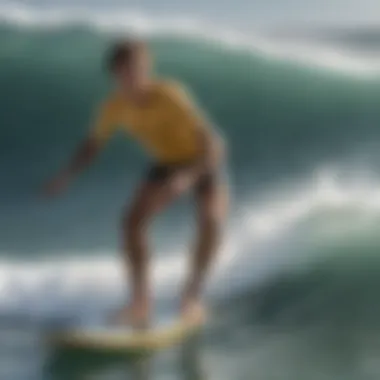Exploring the Mechanics Behind Foil Boards in Surfing


Intro
Foil boards are turning heads in the surfing community, offering a fresh perspective and elevating the overall experience of riding ocean waves. Unlike traditional surfboards that rely solely on buoyancy, foil boards employ a unique setup: a hydrofoil attached to a board, allowing surfers to lift above the water’s surface as they catch waves. This innovative approach not only provides an exhilarating feeling of flight but also opens up new avenues for enjoying water sports.
Surfing Techniques
Beginner Tips for Getting Started
For those just taking their first plunge into the world of foil boarding, success comes down to mastering basic techniques. Ensuring safety is priority number one, so wearing a leash and a helmet is essential. Before hitting the waves, consider the following:
- Selecting the right conditions: Start on a day with lighter winds and smaller waves. This will help you acheive control and minimize the chances of wiping out.
- Body positioning: Shift your body weight towards the front of the board while keeping a low center of gravity. This positioning is vital for balancing as you pop up from the water.
- Practice paddling: Paddle on your stomach before trying to stand. Getting the hang of this will make the transition easier when it’s time to ride.
Learning to foil board requires patience and practice, but remember, every surfer has navigated the same learning curve. Just give it time.
Advanced Maneuvers and Tricks
As your comfort with foil boarding grows, so should your ambitions. Strategically pushing the boundaries of what’s achievable begins with some key maneuvers:
- Carving Turns: Engage your rail and shift your weight as you pivot to carve turns. This will help maintain altitude while changing direction.
- Jumping: Getting airborne requires timing and elevation. Aim for a lip or small wave and use your legs to spring off for a smooth ascent.
- Wavesurfing: This involves using the power of the waves to gain speed and lift. Lean in and shift your bodyweight to ride the wave and stay in control.
"Mastering foil boarding is less about strength and more about finesse and balance. Focus on the rhythm of the water around you, and you'll fly with grace."
Surfboard Selection
Choosing the Right Board for Your Style
Not all foil boards are created equal, and choosing the right one can make or break your experience on the water. Consider your skill level, body weight, and the type of waters you'll be surfing in. Below are common types of boards and their suited styles:
- Beginner boards: Generally broader and more stable. They are forgiving, allowing for easier starts and balance during practice.
- Intermediate boards: A fine balance between speed and stability. Ideal for surfers ready to take their skills to the next level.
- Advanced boards: Lighter and more responsive. Perfect for the seasoned pro looking to perform tricks and navigate complex conditions.
Surfboard Maintenance and Care
To keep your foil board in peak condition, develop a regular maintenance routine:
- Rinse after use: Always wash your board with fresh water after each use to prevent saltwater corrosion.
- Inspect for damage: Check for dings, cracks, or loose components regularly and address issues immediately to keep performance optimal.
- Store properly: Use a board bag and keep it out of direct sunlight to protect the materials and prolong the life of your gear.
Proper care and maintenance will ensure that your foil board not only lasts longer but also performs to its full potential when it’s time to catch some waves.
Prelims to Foil Boards
Foil boards have recently made waves in the surfing world, captivating both seasoned surfers and curious newcomers alike. These innovative boards elevate the rider above the water's surface, creating a unique experience that blends elements of surfing, kiteboarding, and windsurfing. Understanding the fundamentals of foil boards is crucial for anyone looking to ride this exciting wave of technology. They can drastically change how one interacts with the ocean, allowing for a smoother and faster glide that traditional boards can’t quite match.
When talking about the importance of foil boards, one must consider not only the thrill of riding high above the water but also the underlying mechanics that enable such feats. These boards operate on key principles of hydrodynamics and lift, which are essential to grasp for safety and performance. Learning about these elements equips surfers with the knowledge to maximize their skills while minimizing risks.
By exploring the various dimensions of foil boards, surfers can appreciate their advantages over conventional boards and delve into the nuances of choosing the right gear. The ripple effect of this knowledge extends beyond just improving performance; it fosters a deeper respect for the ocean and its dynamics. After all, understanding the tools you’re working with can make the experience safer and way more enjoyable.
What is a Foil Board?
A foil board is a specialized surfboard that features a long mast, a foiling wing, and the board itself. The unique design allows the board to rise above the water rather than staying in constant contact with it. When a surfer gains sufficient speed, the lift generated by the wing creates a feeling akin to flying, as the board soars over the wave.
The anatomy of a foil board may vary, but the essential components remain consistent across models. At its core, a foil board enables surfers to tap into their creativity and explore uncharted territories on the water. This versatility opens up avenues for riding in smaller swells, where conventional boards may struggle to catch a wave.
Historical Context and Evolution
The journey of foil boards goes back to the surf culture of the late 20th century when pioneers were experimenting with hydrofoil technology. While the original designs mimicked those used in windsurfing and sailing, the application of this tech to surfing had relatively slow beginnings. There wasn’t much recognition until the early 2000s, when enthusiasts began to adapt these techniques more explicitly to surf conditions.
What may have seemed merely a niche interest initially has become an ever-growing trend. Today,’s foil boards are made from advanced materials like carbon fiber and composites, making them lighter and more durable than their predecessors. As more riders sought the thrill of high-speed rides above the waves, brands started investing in research and development.
In essence, the evolution of foil boarding isn’t just about the equipment, but also about a shift in mindset. Riders embraced a new way to engage with nature, challenging the idea of what surfing could be. From hawaiian pioneers to modern-day athletes, the foil board’s rich history is a testament to innovation and a love for the ocean that inspires new generations of surfers.
The Science Behind Foil Boards


Foil boards represent a fascinating convergence of science and sport. Their operation hinges on principles rooted in both hydrodynamics and aerodynamics, turning a simple surfing experience into a sophisticated dance with nature's elements. Understanding the scientific intricacies offers surfers an edge; it not only deepens their engagement with the sport but also enhances their ability to navigate various water conditions. Knowledge of foil board mechanics empowers users to refine their skills and make well-informed decisions when riding waves.
Principles of Hydrodynamics
Hydrodynamics, at its core, concerns the behavior of fluids in motion. For surfers, this means grasping how water interacts with their foil boards when they are in use. When a foil board glides through water, the shape of its foil plays a vital role in influencing how it displaces water and generates lift.
The hydrodynamic lift is achieved when water moves over the wings of the foil, generating a pressure difference above and below the surface. Here are some key points to consider:
- Foil Shape: The curvature of the foil's wings determines how efficiently it displaces water and creates lift.
- Speed: Increased speed leads to greater lift. A surfer must maintain sufficient velocity to elevate above the water.
- Angle of Attack: This is the angle between the foil and the incoming water flow. Optimizing it is crucial for maximizing lift without causing excessive drag.
Understanding Lift and Drag
When surfing with a foil board, lift and drag are never far apart. Lift is essential for elevating the board above water, while drag is a result of friction and turbulence that opposes movement. An ideal surfing experience finds the balance between these two forces.
Lift is what most surfers chase. However, too much lift can lead to instability, making it crucial for surfers to develop familiarity with their foil board's performance.
- Lift Generation: Lift increases with speed, foil size, and fluid density.
- Minimizing Drag: Surfboards should be designed to minimize drag via streamlined shapes. Surfers may sometimes adjust their stance to optimize drag reduction.
- Stability: Finding the right balance between lift and drag is necessary for maintaining a steady ride, especially during turns or unexpected wave changes.
Aerodynamics in Surfing
While hydrodynamics covers how foil boards operate underwater, aerodynamics refers to forces at play above the water. As the board rises above the surface, its interaction with the air becomes significant.
Key factors influenced by aerodynamics include:
- Wind Resistance: The board's profile determines how it cuts through the air, impacting a surfer's speed and maneuverability.
- Foil Design: An efficient foil minimizes air resistance, allowing for a smoother transition between water and air.
- Rider Position: A surfer's posture and movements affect aerodynamic efficiency. Leaning forward can cut down wind drag, while a relaxed stance can help maintain stability.
In summary, mastering the science behind foil boarding goes a long way in improving overall performance. By recognizing how hydrodynamics and aerodynamics interact, surfers can take full advantage of their equipment and enjoy a more thrilling ride on the waves.
In essence, the science of foil boards not only operates within the realms of mathematics and physics but also forms a bridge to greater experiences in surfing. Through understanding these principles, surfers can immerse themselves deeper into the artful balance that is foil boarding.
Components of a Foil Board
Understanding the components of a foil board is crucial for both novices and seasoned surfers. Each element plays a dedicated role in achieving the optimal performance and feel when riding on water. By breaking down these parts, surfers can make informed decisions about their equipment and improve their skills on the waves.
The Board: Design and Material
The design and material of the board are foundational aspects influencing all aspects of foil surfing. The board must strike a delicate balance between weight, rigidity, and buoyancy. Common materials for foil boards include fiberglass and carbon fiber, each offering a unique blend of properties. For instance, while fiberglass provides durability and is cost-effective, carbon fiber is lighter and stiffer, which can be beneficial for speed and agility.
When selecting the design, surfers need to consider not just aesthetics but also the shape. A pointed nose reduces drag, allowing the board to slice through water more efficiently. On the other hand, a wider tail can help with stabilization. It's a bit like picking the right pair of shoes: they have to fit well and match the purpose. Ultimately, a well-chosen board impacts not just performance but also the enjoyment of the sport.
The Foil: Anatomy and Function
The foil, often the heart of the setup, is what makes foil boarding unique. Comprised of a wing, a fuselage, and a stabilizer, each part has its purpose. The wing generates lift, which is essential for the board to rise above the water's surface. The fuselage connects the wing to the mast, acting almost like a bridge that facilitates optimal performance.
The lift produced by the foil is dependent on its design: wider wings lift more at slower speeds, while narrower ones require higher speeds but offer rapid maneuverability. Interestingly, too much lift can be a double-edged sword; it can lead to instability. Surfers often spend hours fine-tuning their foil set-up to find the right equilibrium between lift and control. It's a fine dance of physics and feel out there on the water.
The Mast: Connection and Stability
Finally, we have the mast – the unsung hero connecting the foil to the board. The mast comes in various lengths, playing a pivotal role in the board's stability and performance. A longer mast can enhance your ride by allowing for better clearance over waves, whereas a shorter one makes it easier to initiate turns and stay grounded.
Made typically from aluminum or carbon fiber, the choice of mast material similarly impacts weight and flexibility. While aluminum is strong and affordable, carbon fiber offers a weight advantage, enabling faster speeds thanks to less drag. However, it's essential to consider how the mast’s height and material interact with the board and foil to ensure a cohesive performance.
*
The right combination of board, foil, and mast is like crafting a symphony; every element must harmonize for a truly blissful experience on the waves.


When looking at the components as a whole, it’s clear that synergy is key. Each piece doesn’t just work independently, but relies on and enhances the others. This intricate relationship among the components dictates how surfers can ride waves, how fast they go, and ultimately, how much fun they can have on their foil boards.
How Foil Boards Operate
Understanding how foil boards operate is essential for anyone looking to master the waves. It goes beyond merely gliding atop the water; it involves nuanced mechanics that can deeply enhance one's surfing abilities. This section elucidates the pivotal elements of foiling, highlighting the significance of lift and control, while also addressing the techniques necessary to harmonize with nature's gifts—namely, the ocean's currents and swells.
Initiating Lift: The Role of Speed
To initiate lift on a foil board, speed is your best friend. The faster you go, the sooner you’ll feel that exhilarating sensation of lifting above the water. When a foil board is pushed through the water at greater velocities, the specially designed wing begins to generate lift. This phenomenon is guided by Bernoulli's principle, where higher speed over the wing creates lower pressure underneath it.
A keen understanding of speed is crucial here. Surfers should aim for an ideal speed range, which typically falls between 10 to 15 knots, depending on the board type and conditions.
- Tip: Beginners should practice starting on a conventional surfboard before transitioning to a foil board. This foundational experience aids in becoming comfortable with the necessary speeds.
Once you reach the appropriate speed, you’ll notice the board starting to rise. However, it’s not all smooth sailing; you must maintain that speed to keep the lift constant. If you slow down too much, you risk losing that lift and descending back into the water.
Controlling Motion: Balancing Techniques
Mastering lift is just the beginning. Controlling your motion while airborne can feel like trying to juggle watermelons—tricky at first, but with practice, it becomes second nature. Foil boards demand a different approach to balance than traditional surfboards. Here, the learning curve can seem steep, but understanding body positioning and weight distribution will make the ride a lot smoother.
Key components to effective balancing include:
- Positioning: Center yourself over the mast. Your hips should be aligned with the board’s mast for stability. Leaning too far forward or backward can lead you to either nosedive or tailspin.
- Weight Distribution: Shift your weight between your front and back foot to manipulate your direction and height. A slight lean forward will increase speed and lift, while leaning back can help you descend or slow down.
- Small Movements: Unlike other board sports, large movements can throw you off balance. Keep everything subtle; remember, it’s about fluidity, not force.
"The essence of foil boarding lies in blending speed with balance. Once you find that groove, the experience is sublime."
Advantages of Using Foil Boards
Foil boards have stirred up quite a buzz in the surfing community, and for good reason. Knowing the advantages can help both beginners and savvy surfers alike to make the most of their water adventures. These boards offer unique benefits that enhance performance on waves and can change the game for riders. Let's explore these three key advantages: speed efficiency, adaptability to smaller waves, and their versatility across varying water sports scenarios.
Enhanced Speed and Efficiency
One of the standout features of foil boards is their ability to facilitate greater speed compared to traditional surfboards. When a rider starts moving, the foil's shape allows it to slice through water more efficiently. This means a surfer spends less energy paddling and more time cruising. With the foil lifting the board above the water's surface, drag is reduced substantially.
Imagine a seamless ride, feeling the connection between board and wave with minimal resistance. Achieving this sensation means maintaining steady velocity, which is vital for anyone looking to penetrate the swell of competitive riding. The advantage of speed isn't just about racing; it plays a crucial role in catching waves early. Starting earlier grants access to swells before other surfers get to them, effectively giving an edge in positioning.
Ability to Ride Smaller Waves
Foil boards open a whole new world by enabling riders to harness smaller or less powerful waves. Traditional boards often leave surfers waiting for that perfect swell, but with a foil board, riding those subtler ocean movements is more than possible; it becomes a pleasurable experience. This capability means that surfers can take advantage of conditions that might have gone unnoticed or unappreciated previously.
Riders can dance on little waves that might otherwise be too weak to catch, which increases the thrill of the sport. Smaller waves turn into opportunities for exploration and fun, rather than frustration. It’s akin to finding jewels buried in sand—every session can transform into something eye-opening, allowing surfers to refine their skills and confidence across varying types of conditions.
Versatility Across Water Sports
What makes foil boards even more enticing is their versatility. These boards can be adapted for various water sports beyond just surfing, like kiteboarding, windsurfing, or even wakeboarding. The fundamental concept is the same; the added lift from the foil works wonders under multiple circumstances.
This adaptability means you can enjoy the ocean and other water bodies with endless excitement. Look at it this way: why limit yourself to just one sport when a foil board can cater to various thrills? Imagine switching from catching a wave to sailing on a charmed afternoon with a kite overhead.
In navigating sports, enthusiasts can benefit from a holistic approach to water activities, enhancing their skills in one area while applying them across various disciplines. The combination of foil technology and diverse applications makes it a compelling option for anyone passionate about staying active on the water.
Foil boards represent a paradigm shift in how enthusiasts interact with waves, merging speed, versatility, and flexibility into one gripping ride.
Foil Boarding Techniques
Foil boarding techniques are essential for anyone looking to master this innovative way of riding waves. Understanding how to effectively use a foil board can significantly enhance the experience and allow surfers to tap into the full potential of this remarkable equipment. Naturally, mastering these techniques brings heaps of enjoyment, while also featuring the important aspects of safety and control.


Beginner Tips for Foil Surfing
Getting started with foil surfing may feel like jumping into the deep end without floaties. However, with the right approach, newbies can find their footing quite quickly. Here are some practical tips to help beginners get off to a solid start:
- Choose the Right Environment: Start in flat, calm waters before moving to choppy conditions. This will help you get a feel for the foil without the added challenges of waves.
- Gear Selection: Opt for larger foils with more surface area, as they provide better lift and stability. It might also be wise to use a board that’s well-suited for beginners, perhaps something with more buoyancy.
- Positioning: When on the board, position your feet correctly — this prevents the board from tipping over. Keep your feet shoulder-width apart and slightly bend your knees.
- Focus on Balance: Balancing is all about finding that sweet spot. Shifting your weight can instantly affect your lift. Practice by slowly moving your weight forward and backward to get used to how responsive the board is.
- Practice Prone Start: Before attempting to stand, practice lying on your stomach and paddling with your hands. This will aid in understanding how the foil behaves when moving forward.
The initial learning stages may feel a bit precarious, but practicing these tips in a controlled environment will build confidence while keeping safety at the forefront.
Advanced Maneuvers and Tricks
Once a surfer has a decent handle on basic techniques, they might want to step it up a notch. Advanced maneuvers and tricks can bring a new flavor to foil boarding and showcase a deeper mastery of the craft. Here’s a collection of techniques that experienced riders often explore:
- Carving Turns: Mastering smooth, controlled turns elevates the overall experience. By leaning into the turns, one can catch more speed and create fluid motion across the water.
- Jumping: This involves using the lift to propel the foil board off the water. To execute a jump, crouch low then push up while shifting your weight just right to maintain the foil's balance.
- Tacks and Jibes: Tacking and jibing are essential for navigating different winds. These maneuvers require timing and precision, allowing surfers to maintain their forward momentum while changing directions.
- Backflips and Spins: Though typically focusing on the rider's skill, backflips and spins can add an impressive element to a performance. It requires substantial practice, a solid understanding of weight distribution, and quick reactions.
"With great power comes great responsibility. Master the basics before venturing into advanced techniques."
As with anything in sports, the key to success in advanced foil boarding lies in practice and patience. Experimenting with these tricks not only adds excitement but enriches the entire surfing experience.
Choosing the Right Foil Board
Selecting the appropriate foil board is crucial for both performance and enjoyment on the water. With numerous models and variations on the market, surfers must consider a range of factors to ensure they choose a board that meets their needs. The ability to glide effortlessly over waves can be significantly influenced by the type of foil board you ride, making it essential to make an informed decision.
Factors to Consider
When choosing a foil board, several elements should be taken into account:
- Skill Level: Beginner surfers may want to opt for a more stable board with a larger surface area, which allows for easier balance and control. Advanced surfers, on the other hand, might prefer a smaller, more agile board that offers heightened maneuverability.
- Board Size: The length and width of the board can significantly affect performance. A board that's too small may be difficult to balance on, while one that's too big might hinder quick turns. It’s important to find the right fit for your weight and height.
- Foil Design: Different foil configurations can create varying lift and speed. Some foils are designed for quick take-off, while others are made for sustained speed. Consider what fits your intended surfing style.
- Wave Conditions: The local surf conditions play a big role in your board selection. For example, larger, choppier waves may require a different setup than smaller, glassy ones.
- Personal Preferences: Ultimately, some surfers might favor aesthetics, while others might look for specific performance traits. Take the time to discover what feels comfortable to you.
"Choosing the right foil board is like picking the right tool for a job. What works well in one scenario may not in another."
Popular Brands and Models
The market boasts several reputable brands known for their quality and innovation in foil boards. Here are some popular options to consider:
- Slingshot Sports: Their foil boards are favored for durability and performance across varying conditions. Models like the Slingshot Hover Glide are particularly praised for their versatility.
- Naish: Known for robust construction, Naish's boards often cater to all levels of surfers, offering models like the Naish S26 Hover that blend agility and stability.
- Liquid Force: Their focus on user-friendly designs makes them a popular choice among beginners. The Liquid Force Foil Fish model is ideal for those starting out, offering a smooth ride.
- Go Foil: More specialized, Go Foil boards attract advanced riders seeking competitive performance. Their unique hydrofoil designs enable high speeds and responsive turns.
- Armstrong Foils: This brand is recognized for cutting-edge technology, with the Armstrong HA series providing sleek design and exceptional lift.
In the end, aligning your personal needs with the right equipment can reignite your excitement for foil boarding and allow you to fully embrace the experience. Whether you’re just starting out or are ready to push your skills to the next level, understanding your options is the first step to conquering the surf.
Future of Foil Boarding
The future of foil boarding stands on the cusp of remarkable innovation. As surfers continuously seek to enhance their experience on the water, it’s crucial to understand what lies ahead in the world of this exhilarating sport. With ongoing advancements in technology and an increasing interest in competitive events, the next few years are poised to redefine the dynamics of foil boarding.
Innovative Technologies on the Horizon
The development of new materials and designs is reshaping the landscape of foil boarding. One of the most exciting advancements is the integration of smart technology in foil boards. Imagine being able to track your speed, lift, and even your performance metrics through an app. Companies are working on incorporating sensors into boards that can relay real-time data to riders. This could offer feedback for immediate improvement and an enhanced understanding of their performance.
Additionally, advancements in hydrofoil designs are leading to more efficient boards that can better achieve lift with minimal drag. These improvements will enable surfers to glide smoothly and effortlessly over water, even in small waves. The introduction of ultra-lightweight materials, such as carbon fiber, is also expected. These will not only increase maneuverability but also improve durability, making foil boarding more accessible to those of varied skill levels.
- Lightweight materials and designs: Enhanced maneuverability and performance.
- Smart technology integration: Real-time data for immediate feedback and improvement.
- Increased accessibility: Innovations will open doors for novices to experience foil boarding more easily.
This slew of technological advancements signals a bright future, as surfers, regardless of their experience level, can soon fully optimize their skills.
Potential for Competitive Foil Events
As interest in foil boarding grows, it naturally leads to the burgeoning potential for competitive events. There's an increasing buzz around holding foil-specific competitions that could attract talented surfers and spectators alike. Events dedicated just to foil boarding would not only showcase the speed and technical proficiency required but also inspire new and existing enthusiasts to get involved.
Running competitions allows for the evolution of unique disciplines too, including freestyle and distance challenges that play to the strengths of foil boarding. Such categorization would likely draw a wider array of competitors, thereby fostering a vibrant community of foil boarders. With the inclusion of foil boarding in the sports repertoire, we could see it featured in global events like the Olympics, which could provide a massive boost to its visibility and credibility.
"Through competitive foil events, the sport will likely attract more media attention and sponsorship opportunities, laying the groundwork for future growth."
Understanding the future of foil boarding is more than just keeping up with trends. It’s about integrating new technology, creating competitive environments, and engaging a community that thrives on the challenges and the beauty of mastering the waves. As we navigate this evolving landscape, those invested in foil boarding will no doubt find themselves riding the crest of an exciting new wave.



